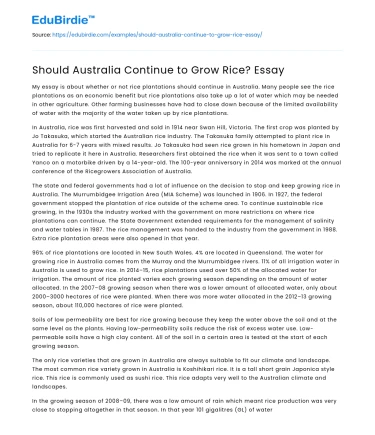My essay is about whether or not rice plantations should continue in Australia. Many people see the rice plantations as an economic benefit but rice plantations also take up a lot of water which may be needed in other agriculture. Other farming businesses have had to close down because of the limited availability of water with the majority of the water taken up by rice plantations.
In Australia, rice was first harvested and sold in 1914 near Swan Hill, Victoria. The first crop was planted by Jo Takasuka, which started the Australian rice industry. The Takasuka family attempted to plant rice in Australia for 6-7 years with mixed results. Jo Takasuka had seen rice grown in his hometown in Japan and tried to replicate it here in Australia. Researchers first obtained the rice when it was sent to a town called Yanco on a motorbike driven by a 14-year-old. The 100-year anniversary in 2014 was marked at the annual conference of the Ricegrowers Association of Australia.
Save your time!
We can take care of your essay
- Proper editing and formatting
- Free revision, title page, and bibliography
- Flexible prices and money-back guarantee
The state and federal governments had a lot of influence on the decision to stop and keep growing rice in Australia. The Murrumbidgee Irrigation Area (MIA Scheme) was launched in 1906. In 1927, the federal government stopped the plantation of rice outside of the scheme area. To continue sustainable rice growing, in the 1930s the industry worked with the government on more restrictions on where rice plantations can continue. The State Government extended requirements for the management of salinity and water tables in 1987. The rice management was handed to the industry from the government in 1988. Extra rice plantation areas were also opened in that year.
96% of rice plantations are located in New South Wales. 4% are located in Queensland. The water for growing rice in Australia comes from the Murray and the Murrumbidgee rivers. 11% of all irrigation water in Australia is used to grow rice. In 2014–15, rice plantations used over 50% of the allocated water for irrigation. The amount of rice planted varies each growing season depending on the amount of water allocated. In the 2007–08 growing season when there was a lower amount of allocated water, only about 2000–3000 hectares of rice were planted. When there was more water allocated in the 2012–13 growing season, about 110,000 hectares of rice were planted.
Soils of low permeability are best for rice growing because they keep the water above the soil and at the same level as the plants. Having low-permeability soils reduce the risk of excess water use. Low-permeable soils have a high clay content. All of the soil in a certain area is tested at the start of each growing season.
The only rice varieties that are grown in Australia are always suitable to fit our climate and landscape. The most common rice variety grown in Australia is Koshihikari rice. It is a tall short grain Japonica style rice. This rice is commonly used as sushi rice. This rice adapts very well to the Australian climate and landscapes.
In the growing season of 2008–09, there was a low amount of rain which meant rice production was very close to stopping altogether in that season. In that year 101 gigalitres (GL) of water was used for rice, 761 GL was used for sugar and 1012 GL were used for all the other cereals. Australian rice farmers use 50% less water than the global average.
With rice and cotton plantations taking up lots of water, other farmers are running out of water. Lack of water during this drought season has caused many grain mills to close. Small family farms which grow more important crops than rice like wheat, fruit and vegetables are also closing down causing big money losses in the nearby regions. Before large-scale rice plantations came to Australia, these small farms were able to make a lot of money, but now these farms are also closing down.
Growing rice in Australia does improve the economy and provide a staple to most of the world. Australian rice does use less water than the world average. By growing rice in Australia, there are also many disadvantages. Growing rice does use up a lot of water which is not good during the drought seasons. South Australian farmers are also suffering from a lack of water. Many small farms which used to have a large income are now closing down since the introduction of large-scale rice plantations.
In my personal opinion, I think rice plantations should only continue in Australia if it is sustainable. Rice plantations should be the lowest priority when it comes to water allocations. The areas used for rice plantations should be used for other crops when rice plantations aren’t sustainable enough. Many other crops can grow in the areas where rice plantations occur.






 Stuck on your essay?
Stuck on your essay?

